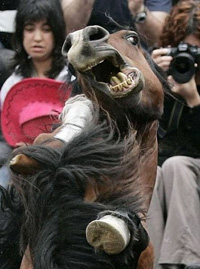 June marks the beginning of the annual roundup of horses in the Spanish province of Galicia, which continues at various villages throughout August. Known as Rapa das Bestas, the tradition is said to date back to the Bronze Age, when Celtic tribes that had migrated to the far northwestern region of the Iberian Peninsula corralled and subdued wild horses.
June marks the beginning of the annual roundup of horses in the Spanish province of Galicia, which continues at various villages throughout August. Known as Rapa das Bestas, the tradition is said to date back to the Bronze Age, when Celtic tribes that had migrated to the far northwestern region of the Iberian Peninsula corralled and subdued wild horses.
One of the oldest “modern” Rapas das Bestas festivals has been celebrated in the same way for the last five centuries, in San Lorenzo de Sabucedo. Legend has it that two sisters, who prayed to San Lorenzo (Saint Laurence) for deliverance from the Black Plague ravaging Europe in the mid-1500s, offered their finest mares in gratitude for answered prayers. The descendants of those mares, referred to as the “saint’s cavalry,” can be recognized today by a special identifying notch on their ears, as well as by embedded microchips.
The rapa (shearing) begins with an early morning mass in honor of the village’s patron saint, after which locals round up hundreds of horses from a field above the town and drive them into a centuries old, round stone corral next to the church.
Foals are separated from the herd before the action begins. Then with the main herd packed into the corral, aloitadors or “tamers” leap onto the horses’ backs and wrestle them to the ground, in order to clip their manes and tails with scissors and to brand the yearling colts.
The initial action is similar to steer wrestling, except that aloitadors launch from a stone wall into a milling herd and don’t have the advantage of horns for handles. The Spanish writer Borobo claimed that the running of the bulls in Pamplona is “a game for children” compared to the Rapa das Bestas of Sabucedo. Sabucedo’s is one of the few Galician rapas where no ropes are used – just bare hands.
In past centuries, horsehair gathered during rapas was a valuable commodity. Today, rapas are popular spectator events and tourist attractions, sometimes associated with horse fairs and sales.
At the end of the Rapa das Bestas at Sabucedo, which lasts for three days, foals are reunited with their dams and the entire herd is driven back to pasture. The Galician regional government’s department of agriculture monitors the breeding of Galician Mountain Horses used in the annual rapas.
